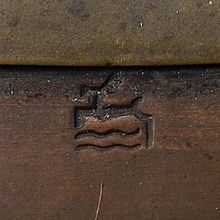Ursula Bach-Wild
Ursula Bach-Wild (born January 8, 1903 in Schwerte ; † March 10, 1987 in Münster ) was a German goldsmith and artisan .
Life
Ursula Bach-Wild was born in Schwerte, the fourth of five daughters of the accountant August Bach and his wife Emilie Bach. In 1912 the family moved to Münster (Westphalia). Ursula Bach began studying at the art school in Münster in 1919, among others with the painters Bernhard Bröker, the sculptor Anton Rüller and Max Barth. In 1920 she met Erhard Wild (1900–1967). In 1921 she attended the art school in Kassel for one semester, and in 1925 she studied for one semester at the art school in Berlin-Charlottenburg. Ursula Bach married Erhard Wild in 1926 and together they founded the Bach-Wild metal workshop in Münster. The two sons were born in 1927 and 1929. In 1930 the couple separated and Erhard Wild began studying at the Düsseldorf Art Academy .
From 1931, Ursula Bach-Wild continued to run the flourishing workshops alone. Her sister, the textile artist Lotte Bach, set up a studio in Ursula Bach-Wild's workshop, and sales took place in shared business premises. In 1933 Ursula Bach-Wild passed her master craftsman examination as chaser master at the Münster Chamber of Crafts . Ursula Bach-Wild divorced in 1935. The workshop was evacuated from Münster in 1944 to Haus Kückeling / Nottuln. After Erhard Wild's return from the war in 1945, the couple were reunited, but a second divorce was carried out in 1948. Ursula Bach-Wild set up another sales room in Münster in 1949. In 1973 she handed over the metal workshops to master gold and silversmith Johannes Wistuba. Ursula Bach-Wild died on March 10, 1987 in Münster.
plant
At the beginning of the 1920s Ursula Bach made wood (or linoleum) cuts in an expressionist style. Above all, she made liturgical implements , crucifixes, altars, tabernacles , religious wall decorations as well as sophisticated arts and crafts and jewelry until her death according to her own designs . Ursula Bach-Wild was a member of the St. Lukas Community in Münster. Her overall work is extensive, the individual pieces are excellently crafted. In the metal workshops of Bach-Wild, up to 10–15 employees were at times occupied with the work based on the artist's designs.
Between 1925 and 1960 she carried out numerous commissions for churches in Westphalia and beyond. Many of the chalices , monstrances , cibories , altar crosses and candlesticks are still used today during masses. Ursula Bach-Wild made very impressive crucifixes for churches and chapels as well as for private households at a young age . The pieces cast in bronze based on models were subsequently reworked, chiselled and polished in a second work step and each has a unique character. The work of Ursula Bach-Wild always received a lot of attention. In 1961 she won third prize at the exhibition of the gold and silversmiths of Westphalia in Rheine.
The individual works and designs bear the artist's signature. Especially the works from the early years up to around 1930 are characterized by the Art Deco style . The workshop's silver and gold jewelry production was extensive in the 1930s to 1960s. Brooches, rings, pendants, necklaces and much more were created. Objects for everyday use were also designed, including candlesticks, flower pots, and bookends. After 1945 jewelry was also made from brass and copper . In the 1940s to 1960s Ursula Bach-Wild produced chased and engraved pewter utensils , as well as glass coasters with motifs from Münster, which have been preserved in large numbers in private households to this day.
Exhibitions
The Münster City Museum showed some of Ursula Bach-Wild's works in two presentations in cabinet 33 of the permanent exhibition:
- 2001/2002 Ursula Bach-Wild. Religious arts and crafts (new acquisition) , City of Münster - exhibition information
- 2003 Ursula Bach-Wild. Exhibition for the 100th birthday , City of Münster - exhibition information
The Münster City Museum owns a small selection of the sculptural works by Ursula Bach-Wild and a large number of sketches and design drawings, especially for liturgical implements.
literature
- Helmut Ebert: Bach-Wild, Ursula . In: Lexicon of the visual and creative artists in Westphalia-Lippe . Münster 2001, ISBN 3-402-05458-2 , p. 17.
- Sabine Heitmeyer-Löns: Lotte Bach. Textile handicraft from six decades . Heimatverein Vreden (Ed.), Vreden 1992, ISBN 3-926627-12-3 [with information on Ursula Bach]
- Christoph Stiegemann (Ed.): "What you inherit from your fathers ...". Art inventory in the Archdiocese of Paderborn . Diözesanmuseum Paderborn, 1998. In it Ursula Bach-Wild: pp. 188–189 (Reliquary, 1927), pp. 190–191 (Monstrance and drafts), ISBN 3-931664-07-4 .
- Tobias Schrörs: The DSH, a total work of art. An art-historical approach to the architecture and furnishings of the house . In: Community and Communication. 75 years of the German student residence . German student dormitory, Association of old Breulians (ed.), Münster [2003], pp. 43–44.
- Art Déco with an unmistakable style. City museum shows Ursula Bach-Wild . In: Westfälische Nachrichten, Aschendorff, Münster, December 21, 2001.
- Handicrafts in portrait: Ursula Bach-Wild. Delicate lines in metal . In: Westfälische Nachrichten, Aschendorff, Münster, September 2, 1972.
Individual evidence
- ↑ Archived copy ( Memento of the original dated November 12, 2013 in the Internet Archive ) Info: The archive link was inserted automatically and has not yet been checked. Please check the original and archive link according to the instructions and then remove this notice.
| personal data | |
|---|---|
| SURNAME | Bach-Wild, Ursula |
| BRIEF DESCRIPTION | German goldsmith and artisan |
| DATE OF BIRTH | January 8, 1903 |
| PLACE OF BIRTH | Swords |
| DATE OF DEATH | March 10, 1987 |
| Place of death | Muenster |


